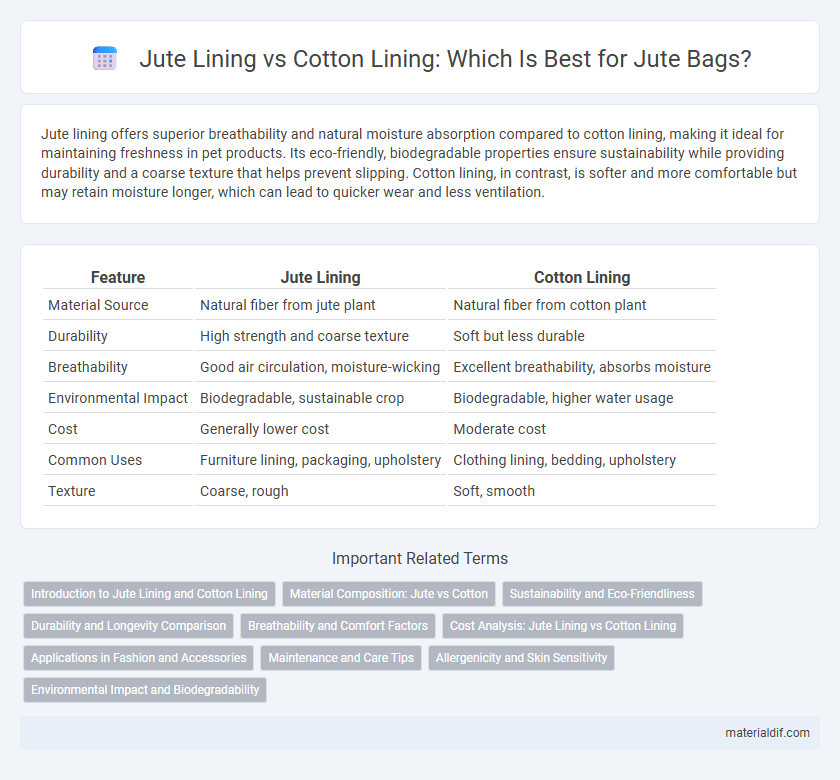Jute lining offers superior breathability and natural moisture absorption compared to cotton lining, making it ideal for maintaining freshness in pet products. Its eco-friendly, biodegradable properties ensure sustainability while providing durability and a coarse texture that helps prevent slipping. Cotton lining, in contrast, is softer and more comfortable but may retain moisture longer, which can lead to quicker wear and less ventilation.
Table of Comparison
| Feature | Jute Lining | Cotton Lining |
|---|---|---|
| Material Source | Natural fiber from jute plant | Natural fiber from cotton plant |
| Durability | High strength and coarse texture | Soft but less durable |
| Breathability | Good air circulation, moisture-wicking | Excellent breathability, absorbs moisture |
| Environmental Impact | Biodegradable, sustainable crop | Biodegradable, higher water usage |
| Cost | Generally lower cost | Moderate cost |
| Common Uses | Furniture lining, packaging, upholstery | Clothing lining, bedding, upholstery |
| Texture | Coarse, rough | Soft, smooth |
Introduction to Jute Lining and Cotton Lining
Jute lining is made from natural jute fibers, offering excellent breathability, moisture absorption, and eco-friendly properties, making it ideal for sustainable textile applications. Cotton lining provides a soft, smooth texture with high absorbency and durability, commonly used in garments and upholstery for added comfort. Both linings serve unique purposes, with jute emphasizing biodegradability and cotton focusing on softness and versatility.
Material Composition: Jute vs Cotton
Jute lining consists of natural fibers derived from the jute plant, known for its coarse texture and high durability, making it ideal for heavy-duty applications. Cotton lining is composed of soft, breathable fibers from the cotton plant, offering superior comfort and moisture absorption in garments. The material composition of jute provides strength and eco-friendliness, while cotton excels in softness and skin-friendliness, influencing the choice based on durability versus comfort needs.
Sustainability and Eco-Friendliness
Jute lining offers superior sustainability compared to cotton lining due to its biodegradability, low water consumption during cultivation, and minimal need for pesticides. Cotton lining, while natural, requires significantly higher water usage and often involves chemical treatments that increase its environmental footprint. Choosing jute lining supports eco-friendly manufacturing practices by reducing resource depletion and promoting soil health.
Durability and Longevity Comparison
Jute lining offers superior durability due to its coarse natural fibers, providing excellent resistance to wear and tear compared to cotton lining. The high tensile strength of jute contributes to its longer lifespan, making it ideal for heavy-use applications. Cotton lining, while softer and more comfortable, tends to degrade faster under constant friction and moisture exposure.
Breathability and Comfort Factors
Jute lining offers superior breathability due to its natural, coarse fibers that allow air circulation and moisture absorption, making it ideal for hot and humid climates. Cotton lining provides a softer texture and enhanced comfort against the skin but may trap heat more than jute. Both materials are biodegradable, yet jute excels in durability and moisture wicking, while cotton is preferred for its gentle feel and hypoallergenic properties.
Cost Analysis: Jute Lining vs Cotton Lining
Jute lining offers a cost-effective alternative to cotton lining, with prices generally 20-30% lower due to jute's rapid growth and lower processing requirements. Cotton lining, while often preferred for softness and durability, incurs higher production costs linked to its intensive cultivation and treatment processes. Evaluating overall expenditure, jute lining significantly reduces material costs, making it suitable for budget-conscious applications without compromising basic functionality.
Applications in Fashion and Accessories
Jute lining offers a durable, eco-friendly alternative to cotton lining in fashion and accessories, providing natural breathability and moisture-wicking properties ideal for sustainable footwear and bags. Cotton lining is softer and more flexible, making it suitable for comfortable garments and lightweight accessories that require a gentle touch on the skin. Both materials enhance product functionality, but jute's coarse texture supports structured designs while cotton's smooth feel suits casual, everyday wear.
Maintenance and Care Tips
Jute lining requires minimal maintenance, as it is naturally resistant to dirt and mildew, needing only occasional brushing and airing to keep fresh. Cotton lining demands more frequent washing and careful handling to prevent shrinkage and deterioration, especially after exposure to moisture. For durability, jute lining is ideal for items subjected to rough use, while cotton lining suits products requiring softness and regular cleaning.
Allergenicity and Skin Sensitivity
Jute lining exhibits low allergenicity due to its natural, hypoallergenic fibers, making it suitable for sensitive skin and reducing the risk of irritation compared to synthetic alternatives. Cotton lining is also hypoallergenic but offers superior softness and breathability, which enhances comfort for those with highly sensitive or allergy-prone skin. Both materials provide effective natural options, yet cotton's finer weave offers a gentler touch, while jute's coarser texture caters to durability and moisture resistance without aggravating skin conditions.
Environmental Impact and Biodegradability
Jute lining offers a significantly lower environmental impact compared to cotton lining due to its rapid growth cycle and minimal pesticide use, resulting in reduced soil degradation and water consumption. Biodegradability of jute is superior, as it decomposes quickly without releasing harmful chemicals, whereas cotton, though natural, may require intensive chemical treatments during processing that can affect its eco-friendliness. The sustainable cultivation practices and natural fiber properties of jute make it an eco-conscious alternative to conventional cotton linings in textile applications.
Jute Lining vs Cotton Lining Infographic

 materialdif.com
materialdif.com